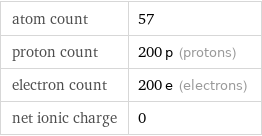Input interpretation
![diazene, bis[4-(pentyloxy)phenyl]-, 1-oxide | electron count](../image_source/341c352d2bf59d882df5f2899b5c82c0.png)
diazene, bis[4-(pentyloxy)phenyl]-, 1-oxide | electron count
Result
![Determine the number of electrons in: diazene, bis[4-(pentyloxy)phenyl]-, 1-oxide (C_22H_30N_2O_3) Plan: • Use the summation: N_electrons = sum_i N_i Z_i. • Determine the values of N_i and Z_i. • Compute the number of electrons. Use the chemical formula, C_22H_30N_2O_3, to count the number of atoms, N_i, for each element: | N_i C | 22 H | 30 N | 2 O | 3 Look up the atomic number, Z_i, for each element in the periodic table. The number of electrons per atom is equal to the atomic number: | N_i | Z_i C | 22 | 6 H | 30 | 1 N | 2 | 7 O | 3 | 8 Multiply N_i by Z_i to compute the number of electrons for each element: | N_i | Z_i | N_i Z_i C | 22 | 6 | 22 × 6 = 132 H | 30 | 1 | 30 × 1 = 30 N | 2 | 7 | 2 × 7 = 14 O | 3 | 8 | 3 × 8 = 24 Sum the N_i Z_i terms to compute the number of electrons, N_electrons: Answer: | | N_electrons = 132 + 30 + 14 + 24 = 200](../image_source/d9f799c4d402b3afd6a8ee3977943579.png)
Determine the number of electrons in: diazene, bis[4-(pentyloxy)phenyl]-, 1-oxide (C_22H_30N_2O_3) Plan: • Use the summation: N_electrons = sum_i N_i Z_i. • Determine the values of N_i and Z_i. • Compute the number of electrons. Use the chemical formula, C_22H_30N_2O_3, to count the number of atoms, N_i, for each element: | N_i C | 22 H | 30 N | 2 O | 3 Look up the atomic number, Z_i, for each element in the periodic table. The number of electrons per atom is equal to the atomic number: | N_i | Z_i C | 22 | 6 H | 30 | 1 N | 2 | 7 O | 3 | 8 Multiply N_i by Z_i to compute the number of electrons for each element: | N_i | Z_i | N_i Z_i C | 22 | 6 | 22 × 6 = 132 H | 30 | 1 | 30 × 1 = 30 N | 2 | 7 | 2 × 7 = 14 O | 3 | 8 | 3 × 8 = 24 Sum the N_i Z_i terms to compute the number of electrons, N_electrons: Answer: | | N_electrons = 132 + 30 + 14 + 24 = 200
Particle counts

atom count | 57 proton count | 200 p (protons) electron count | 200 e (electrons) net ionic charge | 0
Corresponding quantity

Moles of electrons from n = N/N_A: | 3.3×10^-22 mol (moles)